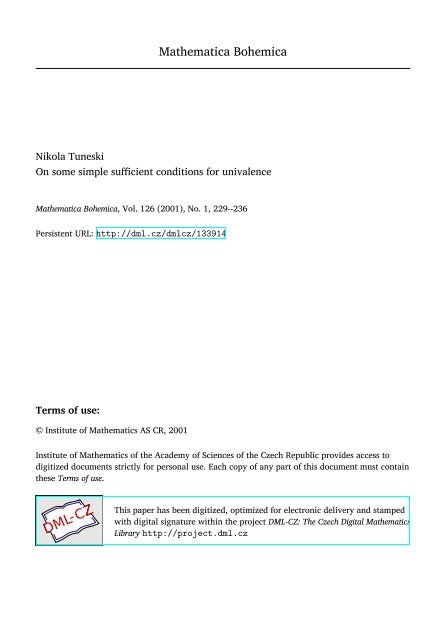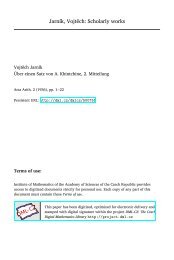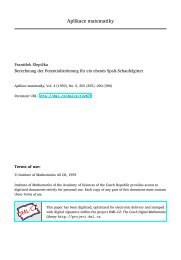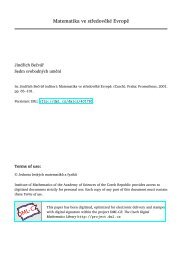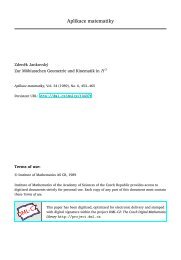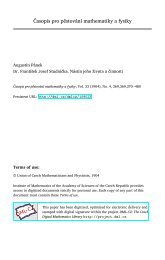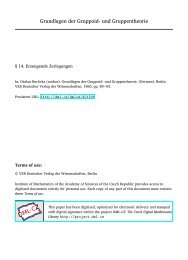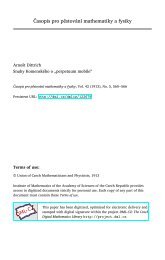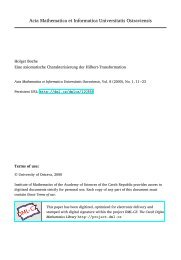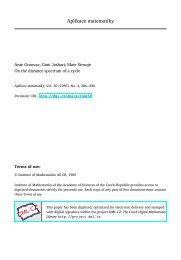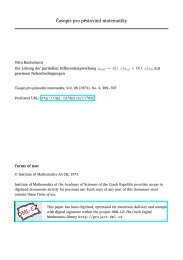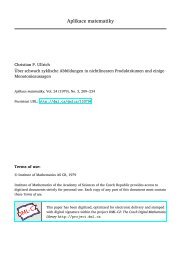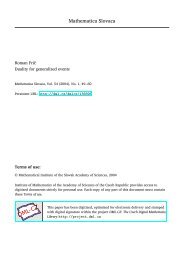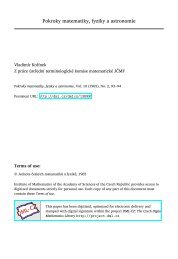On some simple sufficient conditions for univalence
On some simple sufficient conditions for univalence
On some simple sufficient conditions for univalence
You also want an ePaper? Increase the reach of your titles
YUMPU automatically turns print PDFs into web optimized ePapers that Google loves.
Mathematica Bohemica<br />
Nikola Tuneski<br />
<strong>On</strong> <strong>some</strong> <strong>simple</strong> <strong>sufficient</strong> <strong>conditions</strong> <strong>for</strong> <strong>univalence</strong><br />
Mathematica Bohemica, Vol. 126 (2001), No. 1, 229--236<br />
Persistent URL: http://dml.cz/dmlcz/133914<br />
Terms of use:<br />
© Institute of Mathematics AS CR, 2001<br />
Institute of Mathematics of the Academy of Sciences of the Czech Republic provides access to<br />
digitized documents strictly <strong>for</strong> personal use. Each copy of any part of this document must contain<br />
these Terms of use.<br />
This paper has been digitized, optimized <strong>for</strong> electronic delivery and stamped<br />
with digital signature within the project DML-CZ: The Czech Digital Mathematics<br />
Library http://project.dml.cz
126 (2001) MATHEMATICA BOHEMICA No. 1, 229–236<br />
ON SOME SIMPLE SUFFICIENT CONDITIONS FOR UNIVALENCE<br />
Nikola Tuneski, Skopje<br />
(Received June 8, 1999)<br />
Abstract. In this paper <strong>some</strong> <strong>simple</strong> <strong>conditions</strong> on f ′ (z) andf ′′ (z) whichleadto<strong>some</strong><br />
subclasses of univalent functions will be considered.<br />
Keywords: univalent, starlike, sharp result<br />
MSC 2000 : 30C45<br />
1. Introduction and preliminaries<br />
Let A denote the class of analytic functions f(z) in the unit disc U = {z : |z| < 1}<br />
and normalized so that f(0) = f ′ (0) − 1=0.<br />
A function f(z) ∈ A is said to be starlike of order α, i.e., to belong to S ∗ (α),<br />
0 αα<br />
f(z)<br />
<strong>for</strong> all z ∈ U. Then S ∗ = S ∗ (0) is the class of starlike functions in the unit disc<br />
U. Further, ˜S ∗ (α), 0
In addition to these classes we will deal also with the following ones:<br />
R(α) = { f(z) ∈ A: Re{f ′ (z)} >α, z∈ U } , 0 α
2. Conditions on f ′′ (z)<br />
Theorem 1. If f(z) ∈ A and |f ′′ (z)| k, z ∈ U, 0
ÊÑÖ 1. For α =0(k = 1) in Corollary 1 we get Theorem 1 from [4].<br />
Corollary 1.1. Let f(z) ∈ A. Then<br />
(i) |f ′′ (z)| 4/5 implies f(z) ∈ S ∗ (1/3);<br />
(ii) |f ′′ (z)| 2/3 implies f(z) ∈ S ∗ (1/2); and<br />
(iii) |f ′′ (z)| 1/2 implies f(z) ∈ S ∗ (2/3).<br />
Corollary 2. If f(z) ∈ A and |f ′′ (z)| 2sin(αÔ/2)/(1 + sin(αÔ/2)) = k, z ∈ U,<br />
0
ÈÖÓÓ.<br />
The condition |f ′′ (z)| k, z ∈ U, isequivalentto<br />
(5) zf ′′ (z) ≺ kz<br />
z ∈ U, and again, using Lemma 2 <strong>for</strong> F (z) =f ′ (z) andG(z) =1+kz, wegetthat<br />
the subordination (4) is true.<br />
□<br />
Corollary 3. If f(z) ∈ A and |f ′′ (z)| (1 − α)/(2 − α) =k, z ∈ U, 0 αkand<br />
{<br />
Re 1+ zf′′ (z)<br />
}<br />
1+2z(k + ε)<br />
f ′ =<br />
(z) 1+z(k + ε)<br />
is smaller than α when z is real and close to −1, i.e., f(z) /∈ K(α).<br />
□<br />
233
ÊÑÖ 3. For α = 0, i.e., k =1/2, Corollary 3 is equivalent to Theorem 3<br />
from [4].<br />
Corollary 3.1. Let f(z) ∈ A. Then<br />
(i) |f ′′ (z)| 2/5 implies f(z) ∈ K(1/3);<br />
(ii) |f ′′ (z)| 1/3 implies f(z) ∈ K(1/2); and<br />
(iii) |f ′′ (z)| 1/4 implies f(z) ∈ K(2/3).<br />
Corollary 4. If f(z) ∈ A and |f ′′ (z)| 1 − α = k, z ∈ U, 0 α 1 − k = α <strong>for</strong> z ∈ U, f(z) ∈ R(α).<br />
<strong>On</strong>ce again, using the function f(z) =z +(k + ε)z 2 /2, 0 0, <strong>for</strong><br />
which |f ′′ (z)| = k + ε>kand f ′ (z) =1+(k + ε)z is smaller than α when z is real<br />
and close to −1, we prove that the result of the corollary is sharp.<br />
□<br />
Corollary 4.1. Let f(z) ∈ A. Then<br />
(i) |f ′′ (z)| 2/3 implies f(z) ∈ R(1/3);<br />
(ii) |f ′′ (z)| 1/2 implies f(z) ∈ R(1/2);<br />
(iii) |f ′′ (z)| 1/3 implies f(z) ∈ R(2/3).<br />
Corollary 5. If f(z) ∈ A and |f ′′ (z)| sin(αÔ/2) = k, z ∈ U, 0 k<br />
and sup | arg f ′ (z)| =arcsin(k + ε) > arcsin k = αÔ/2 <strong>for</strong>ε>0 small enought. □<br />
z∈U<br />
Corollary 5.1. Let f(z) ∈ A. Then<br />
(i) |f ′′ (z)| 1/2 implies f(z) ∈ R 1/3 ;<br />
(ii) |f ′′ (z)| √ 2/2 =0, 7071 ... implies f(z) ∈ R 1/2 ;and<br />
(iii) |f ′′ (z)| √ 3/2 =0, 8660 ... implies f(z) ∈ R 2/3 .<br />
234
3. Condition on f ′ (z)<br />
Theorem 3. Let f(z) ∈ A. If |f ′ (z) − 1|
We can rewrite Theorem 3 in the following way.<br />
Theorem 3 ′ . Let f(z) ∈ A, 0


